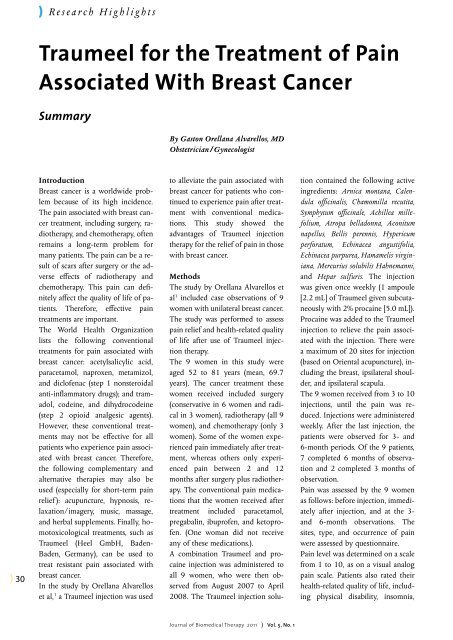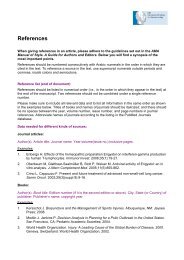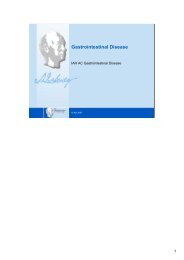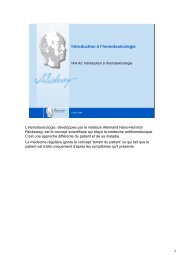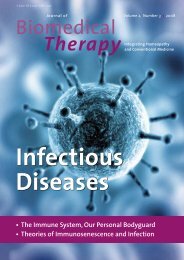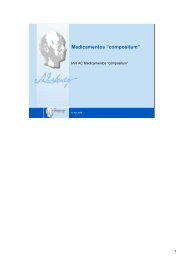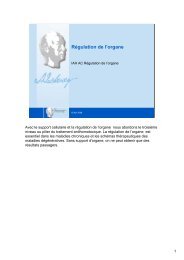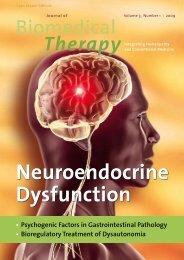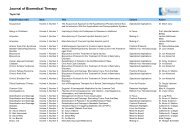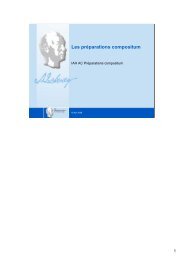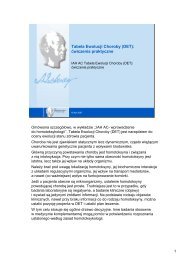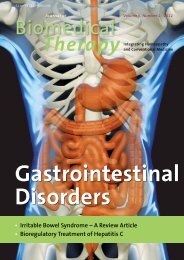Biomedical Therapy - International Academy of Homotoxicology
Biomedical Therapy - International Academy of Homotoxicology
Biomedical Therapy - International Academy of Homotoxicology
Create successful ePaper yourself
Turn your PDF publications into a flip-book with our unique Google optimized e-Paper software.
) 30<br />
) Research Highlights<br />
Traumeel for the Treatment <strong>of</strong> Pain<br />
Associated With Breast Cancer<br />
Summary<br />
Introduction<br />
Breast cancer is a worldwide problem<br />
because <strong>of</strong> its high incidence.<br />
The pain associated with breast cancer<br />
treatment, including surgery, radiotherapy,<br />
and chemotherapy, <strong>of</strong>ten<br />
remains a long-term problem for<br />
many patients. The pain can be a result<br />
<strong>of</strong> scars after surgery or the adverse<br />
effects <strong>of</strong> radiotherapy and<br />
chemotherapy. This pain can definitely<br />
affect the quality <strong>of</strong> life <strong>of</strong> patients.<br />
Therefore, effective pain<br />
treatments are important.<br />
The World Health Organization<br />
lists the following conventional<br />
treatments for pain associated with<br />
breast cancer: acetylsalicylic acid,<br />
paracetamol, naproxen, metamizol,<br />
and dicl<strong>of</strong>enac (step 1 nonsteroidal<br />
anti-inflammatory drugs); and tramadol,<br />
codeine, and dihydrocodeine<br />
(step 2 opioid analgesic agents).<br />
However, these conventional treatments<br />
may not be effective for all<br />
patients who experience pain associated<br />
with breast cancer. Therefore,<br />
the following complementary and<br />
alternative therapies may also be<br />
used (especially for short-term pain<br />
relief ): acupuncture, hypnosis, relaxation/imagery,<br />
music, massage,<br />
and herbal supplements. Finally, homotoxicological<br />
treatments, such as<br />
Traumeel (Heel GmbH, Baden-<br />
Baden, Germany), can be used to<br />
treat resistant pain associated with<br />
breast cancer.<br />
In the study by Orellana Alvarellos<br />
et al, 1 a Traumeel injection was used<br />
By Gaston Orellana Alvarellos, MD<br />
Obstetrician/Gynecologist<br />
to alleviate the pain associated with<br />
breast cancer for patients who continued<br />
to experience pain after treatment<br />
with conventional medications.<br />
This study showed the<br />
advantages <strong>of</strong> Traumeel injection<br />
therapy for the relief <strong>of</strong> pain in those<br />
with breast cancer.<br />
Methods<br />
The study by Orellana Alvarellos et<br />
al 1 included case observations <strong>of</strong> 9<br />
women with unilateral breast cancer.<br />
The study was performed to assess<br />
pain relief and health-related quality<br />
<strong>of</strong> life after use <strong>of</strong> Traumeel injection<br />
therapy.<br />
The 9 women in this study were<br />
aged 52 to 81 years (mean, 69.7<br />
years). The cancer treatment these<br />
women received included surgery<br />
(conservative in 6 women and radical<br />
in 3 women), radiotherapy (all 9<br />
women), and chemotherapy (only 3<br />
women). Some <strong>of</strong> the women experienced<br />
pain immediately after treatment,<br />
whereas others only experienced<br />
pain between 2 and 12<br />
months after surgery plus radiotherapy.<br />
The conventional pain medications<br />
that the women received after<br />
treatment included paracetamol,<br />
pregabalin, ibupr<strong>of</strong>en, and ketopr<strong>of</strong>en.<br />
(One woman did not receive<br />
any <strong>of</strong> these medications.).<br />
A combination Traumeel and procaine<br />
injection was administered to<br />
all 9 women, who were then observed<br />
from August 2007 to April<br />
2008. The Traumeel injection solu-<br />
Journal <strong>of</strong> <strong>Biomedical</strong> <strong>Therapy</strong> 2011 ) Vol. 5, No. 1<br />
tion contained the following active<br />
ingredients: Arnica montana, Calendula<br />
<strong>of</strong>ficinalis, Chamomilla recutita,<br />
Symphytum <strong>of</strong>ficinale, Achillea millefolium,<br />
Atropa belladonna, Aconitum<br />
napellus, Bellis perennis, Hypericum<br />
perforatum, Echinacea angustifolia,<br />
Echinacea purpurea, Hamamelis virginiana,<br />
Mercurius solubilis Hahnemanni,<br />
and Hepar sulfuris. The injection<br />
was given once weekly (1 ampoule<br />
[2.2 mL] <strong>of</strong> Traumeel given subcutaneously<br />
with 2% procaine [5.0 mL]).<br />
Procaine was added to the Traumeel<br />
injection to relieve the pain associated<br />
with the injection. There were<br />
a maximum <strong>of</strong> 20 sites for injection<br />
(based on Oriental acupuncture), including<br />
the breast, ipsilateral shoulder,<br />
and ipsilateral scapula.<br />
The 9 women received from 3 to 10<br />
injections, until the pain was reduced.<br />
Injections were administered<br />
weekly. After the last injection, the<br />
patients were observed for 3- and<br />
6-month periods. Of the 9 patients,<br />
7 completed 6 months <strong>of</strong> observation<br />
and 2 completed 3 months <strong>of</strong><br />
observation.<br />
Pain was assessed by the 9 women<br />
as follows: before injection, immediately<br />
after injection, and at the 3-<br />
and 6-month observations. The<br />
sites, type, and occurrence <strong>of</strong> pain<br />
were assessed by questionnaire.<br />
Pain level was determined on a scale<br />
from 1 to 10, as on a visual analog<br />
pain scale. Patients also rated their<br />
health-related quality <strong>of</strong> life, including<br />
physical disability, insomnia,


